A blog with my insight and review of books selected. This is for assignments I am taking with Texas Women University called LS 5603/20-21 Literature for Children and Young Adults course.
Don't wanna be here? Send us removal request.
Text
Genre 6 Fiction, Fantasy, & YA
**This is an assignment for my TWU course LS-5603 of book reviews for Fiction, Fantasy, & YA by P. Johnson.
BOOK 1
Savvy by Ingrid Law

BIBLIOGRAPHY
Law, Ingrid. (2008). Savvy. Narrated by Lily Blau. An Unabridged Audiobook. 9780142414330
PLOT SUMMARY
Mississippi or Mibs for short is a young preteen who awaits her savvy (a special family power) when she turns thirteen in a few days. Her brothers already got their savvy but, she wonders what hers will be. When the time came on her thirteenth birthday, Mibs figured out her savvy and had to get to her Poppa as soon as possible. Fish and Samson her bothers, Bobbi and Will sister and brother end up on a journey to get to Poppa in a distant town. The adventure of Mibs and her families mysterious savvy powers take Mibs on a journey of adventure, suspicion and growth.
CRITICAL ANALYSIS
The format is an audiobook from Audible.com. It is an unabridged version. The narrator is Lily Blau an actress. The sound quality is clear and upbeat. The background effects was music that played in parts of the audiobook. The reading by Lily Blau was only her and she used different tones when speaking for different characters. The listener had a better sense of who was who based off the reading of Lily Blau. As the reader listens to this story she can visualize the scene of events.
Ingrid Law puts together a story of a young girl growing up and how she gets her savvy, and helps to find her voice, while finding a way to eagerly get to her Poppa. The characters in the story are realistic and personalities real people would have. Mibs a soon to be thirteen year old has issues with classmates and watching her little brother just like any other teens. The setting takes place in between Kansas and Nebraska in modern day times. The theme is Mibs has finally gotten her Beaumont’s savvy a special power that passes on to most family members on their thirteen birthday. It was Mibs thirteenth birthday and all she wants to do is get to her Poppa who was in another town in a hospital. She believes her savvy can save him. The style is more of a natural feel and real world living. For example in the book Mibs explains where they live “Settling directly between Nebraska and Kansas in a little place all our own, just off Highway 81, we were well beyond hollering distance from the nearest neighbor, which was the best place to be for a family like ours.” Therefore, Mibs explanation where they live is very realistic and believable. The gender and culture of this story is mainly girl dominate as Mibs is the protagonist in the story. She is the one who is the problem-solver and leads on to get to her Poppa. Overall, this story will have you turning page after page wanting to know what happens next and will this story have a happy ending.
REVIEW EXCERPT(S)
2009 Notable Children’s Books
2009 Newbery Honor Books
From Newbery Honor Book: “This rich first-person narrative draws readers into a wild ride, winding through the countryside on a journey of self-discovery for Mibs Beaumont and her companions.”
CONNECTIONS
Gather other Ingrid Law books such as:
Switch. ISBN 9780142425701
Scumble. ISBN 9780142419625
Use Ingrid Law books to help guide students and have them write a short story and share with the class.
BOOK 2
Speak by Laurie Halse Anderson

BIBLIOGRAPHY
Anderson, Laurie Halse. 1999. Speak. New York: Farrar Straus Giroux. 9780312674397
PLOT SUMMARY
Laurie Anderson creates a story of sadness and eventually growth. Melinda is the protagonist of this story. She is a ninth grade student who does not speak much. Melinda is the narrator and as school progresses she talks about her time in ninth grade. Melinda does not have any friends due to an incident over the summer. As she take classes she starts to enjoy working on an assigned art project. As Melinda ninth grade moves on she starts to realize she needs to speak no matter what.
CRITICAL ANALYSIS
Melinda is quiet and does not speak much after going to a summer party before going to ninth grade. As the reader learns about Melinda and who she is they feel sad. The reader wonders why Melinda is not speaking and who is this IT person that she fears so much. As Melinda moves on with poor grades and still not speaking the reader is curious about her behavior. The setting is in Canada. The theme is the thoughts and events of a young teen going through a tragic situation and how she coped with it. The style is believable which made the reader feel like they were back in high school again. For example when Melinda says “ I make it through the first two weeks of school without a nuclear meltdown.” reminds the reader of the times they went to high school. The gender and culture of this story is girl dominate. Melinda has a conflict that she must face in order for her to move on in life. Melinda finds herself not speaking and found her voice by speaking later.
REVIEW EXCERPT(S)
2000 Printz Honor book
1999 National Book Award Finalist
From Common Sense Media by Norah Caroline Piehl: “This is one of the most devastatingly true painful portrayals of high school to come along in a long time.”
CONNECTIONS
Gather other Laurie Halse Anderson books such as:
Fever: ISBN 9780142411841
Prom: ISBN 9780142405703
Catalyst: ISBN 9780142400012
Wintergirls: ISBN 978060615155
BOOK 3
Rapunzel’s Revenge by Shannon Hale, Dean Hale Illustrated by Nathan Hale
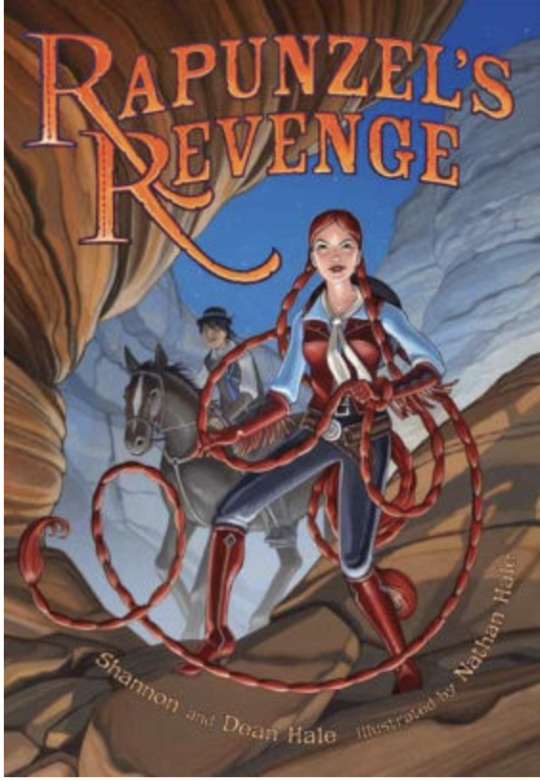
BIBLIOGRAPHY
Hale, Shannon, and Dean Hale. Ill. Nathan Hale. 2008. Repunzel’s Revenge. New York: Bloomsbury. ISBN 9781599902883
PLOT SUMMARY
A young Repunzel is always getting herself into situations. She lives with her mother in a big home surrounded by a very tall wall. Repunzel wanting to know what is beyond the wall is on a mission to get over it and see. Eventually she concurs the wall but, is surprise with what is revealed. In the town she meets a lady. Her mother sends her guard to bring Repunzel back behind the tall wall. Because of her behavior her mother sends her to a tall tree tower. Repunzel’s hair grows and grows. She uses her locks that are braided into two pigtails to escape the tree tower. Repunzel goes through obstacles on her journey for revenge. Eventually Repunzel takes back what is hers and becomes a strong confident young lady.
CRITICAL ANALYSIS
Repunzel is an adventurous curious girl who finds herself in conflict with her mother Gothel. Once the reader learns what Gothel has done, the reader is routing for Repunzel to escape. Her escape was not easy she used her long pigtail braids to help her swing out of the tree tower to freedom. Repunzel sets her revenge with Gothel, on her way she meets a character named Jack. Jack and his goose help Repunzel. As a team they both encounter conflict and have to resolve them. Repunzle starts to realize her hair can be useful when protecting herself and Jack. The reader wonders if Repunzel and Jack have feelings for each other.
The order of events with obstacles and tasks are that Repunzel needs to get back to the town she met the lady and get her out. As soon as Repunzel the reader felt bad for her. Like some unsung hero Repunzel did not land gracefully out the tree tower. “ I managed to lasso the tree...swing gracefully from my prison..”(the illustration shows Repunzel with scared and terrified eyes holding on for dear life to her pigtail as she swung from the tower) “climb down the tree’s branch...Crack! Crash! OOF!” (illustration shows that she did not climb down the tree, Repunzel actually fell on branches all the way down).. “and land triumphantly on the forest floor.” (The reader will see the illustration on Repunzel sitting in a pool of murky water soak and wet) The reader will see this as humorous and laugh at how comedic the words of the story do not match the illustration. Jack and her try to help save a little girl on their journey unfortunately it puts them in even more hot water.
The reader will see that the setting of this graphic novel is in the wild west. Not the typical tale of what the reader has read about Repunzel. It is the wild west with cowboys and mine camps. The reader will want to read more as they learn more about the character Repunzel. The theme is about good overcoming evil. Repunzel is good and needs to seek revenge on Gothel who is evil and a liar who took Repunzel from her family. When Repunzel finally encounters Gothel the unexpected happens but, Repunzel gets back up and is triumphed. The reader will feel happy and excited with the ending of the story and want to read more. Overall, the reader will enjoy this graphic novel and look for other books the author wrote related to this story.
REVIEW EXCERPT(S)
2009 Notable Children’s Books
2009 ALA Graphic Novels for Teens
2009 Great Graphic Novels for Teens
From Kirkus Review: “A beloved fairy tale gets a glossy graphic-novel makeover, reworked in a fanciful Old West setting.”
From Barnes and Noble: “This stunning, hilarious and action-packed graphic novel re-imagines Repunzel’s story...in the wild west!”
CONNECTONS
Gather other Shannon Hale and Dean Hale books to read such as:
Calamity Jack: ISBN 9781599903736
Use Repunzel’s Revenge and Calamity Jack by Shannon Hale and Dean Hale to introduce students in writing a graphic novel based off a know fairy tale. Students will get into groups and collaborate to create an original graphic novel with familiar characters from fairy tales.
1 note
·
View note
Text
Genre 5 History Fiction
**This is an assignment for my TWU course LS-5603 of book reviews for history fiction by P. Johnson.
BOOK 1
Dead end in Norvelt by Jack Gantos
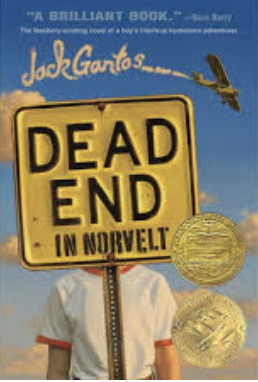
BIBLIOGRAPHY
Gantos, Jack. 2011. Dead End In Norvelt. New York: Farrar Straus Giroux. ISBN 9781250010230
PLOT SUMMARY
Jack Gantos not only is the author but, is the main character in the story. He is at the time a teenage boy who seems to get himself in trouble in a small town called Norvelt. While being adventurous young Jack take a valuable item from is dads Japanese collection and ends up with a bang. “Dead end to Norvelt” is a funny, witty, mysterious adventure within a small town where everyone knows your name.
CRITICAL ANALYSIS
It’s summer time and Jack is feeling adventurous and gets himself grounded. He also has a condition where when he gets excited or spooked he gets pretty bad nosebleeds. Unfortunately, for Jack excitement is all around him. Only adventure at this time is across the street at Miss Volker’s house. His mother has volunteered Jack to help the old lady out. The reader will be interested in how the relationship between Jack and Miss Volker will turn out. After realizing that Jack will be assisting in helping Miss Volker write obituaries, the reader will want to know more. Jack soon realized that Miss Volker is a true historian of the small town of Norvelt. The reader starts to think like Jack that Miss Volker may have a few secrets up her sleeve. Jack starts to investigate when Miss Volker is arrested. Now it is Jacks turn to find out the truth of Miss Volker and the obituary connection. This story is set in the summer time. The plot is a time after the Japanese WWII which his father fought in. In the book Jack states “Down by my feet I had laid out all the Japanese army souvenirs Dad had shipped home from the war” Overall, the reader will find the story very engaging, funny and full of surprises. This historical fiction will have you wanting to learn more about Jack and his adventures and his growth in life.
REVIEW EXCERPT(S)
2012 Newbery Medal
2012 Scott O’Dell Award
From School Library Journal: “A fast-paced and witty read.”
From Booklist: “Gantos, as always, delivers bushels of food for thought and plenty of outright guffaws.”
CONNECTIONS
Gather other Jack Gantos books such as:
From Norvelt to Nowhere: ISBN 9781250062789
BOOK 2
Pictures of Hollis Woods by Patricia Reilly Giff

BIBLIOGRAPHY
Giff, Patricia Reilly. (2002). Pictures of Hollis Woods. Narrated by Hope Davis. An Unabridged Production. ISBN 9780807217863
PLOT SUMMARY
Hollis Woods was left abandoned in a town called Hollis Woods. The mother requested that she be named after the town. Hollis had been in different foster homes throughout her 12 years of life. She talks about her journey and feels she may have finally found her home. “Pictures of Hollis Woods” is an emotional rollercoaster of love, sadness and family. Giff put together an obstacle that Hollis will eventually overcome.
CRITICAL ANALYSIS
The format of this book is put into 3 compact disk (CD’s). It is an unabridged version of the book. The reader is Hope Davis a female actress from a variety of films and was on Broadway. The sound quality of the CD was very smooth and full of expression. The punctuation was clear and the background noise was not noticeable. The listener was able to hear the story even with background music played. The music soundtrack was sweet and soft at times. The voice of characters changed for each by dialect or tone. The beginning of the CD announces the name of the story and the author. As the listener would listen to the story, often they would wonder off in their own imagination and lose track of the story on the CD. At times the listener had to refocus and play over a few chapters to catch what was missed previously. The characters of the story is Hollis. Josie, the social worker, Steven and the Regans. The plot of the story is how Holiis eventually starts as an orphan and then finds love but looses it then finds family. The setting is the flashback of Hollis and her foster families and the situation she is in currently. The theme is the growth of a little girl who eventually feels like she cannot be loved. The reader will feel like rescuing Hollis and telling her where her true family is right before her eyes. The style of the story is inviting and the tone of the voice on the CD at times would fade as the listener listened. The listening of the story would sometimes be engaging in the story at times. The listener felt like the book may have been more inviting for me to see the words. The appeal of the work is interesting but, the listener felt that instead of listening to the story they would have had a better grasp with reading the book. Although it had interesting parts of the story it lacked something the listener can’t seem to figure out. The listener assumes maybe to have a physical book is better than listening to the CD audiobook.
REVIEW EXCERPT(S)
2003 Newbery Medal
2003 Notable Children’s Books
From Kirkus Reviews: The Newbery Honor book about a girl who has never known family fighting for her first true home “ will leave readers....satisfied”
CONNECTIONS
Gather other Patricia Reilly Giff books such as:
Lily’s Crossing. ISBN 9780440414537
Eleven. ISBN 9780440238027
BOOK 3
Between shades of gray by Ruta Septeys

BIBLIOGRAPHY
Sepetys, Ruta. 2011. Between Shades of Gray. New York: Penguin Group. ISBN 9780142420591
PLOT SUMMARY
In “Between Shades of Gray” the character Lina is a teenage girl who describes the journey that her family endured. This story is set in 1941. Lina, her little brother Jonas and mother Elena were taken one night and Lina’s father was no where in sight. Ruta Sepetys has Lina take you on a terrifying and heart wrenching life journey that will make you burst into tears of sadness and even tears of joy.
CRITICAL ANALYSIS
These characters each have a personalty of their own. Lina’s mother Elena is very smart, courageous and spunky. Her little brother is witty and caring. The young man Andrius is calculated and trustworthy. Lina sometimes speaks before thinking and is very artistic. The reader will enjoy reading more about each character and what becomes of them. The plot of the story is the trials and tribulations of the time when Stalin and Hitler had the NKVD or Soviet secret service forged their way into towns taking questionable people due to the views/comments they had. The reader will be upset at how the NKVD treated others. For example “The NKVD officer slammed her in the shoulder with the butt of his riffle, throwing her face-first into the mirror.” This causes anger from the reader at how people were treated back when Lithuania was annexed into the Soviet Union. The theme of the story is how a young teenage girl had to grow up fast to prepare for what was to come for her future. The reader feels that the values the teen transformed are from, a little girl in a nightgown to a young lady taking care of people and speaking her mind. Lina had to be responsible and strategic at how she did things to survive. The style of the story is mainly told in the voice of Lina. There are parts throughout the book in italics that Lina flashes back to times before being taken. The author really made sure that the reader could visualize the moments before Lina’s family and life went upside down. This book is captivating and an emotional rollercoaster of grief, love, and strength. Be ready for this historical fiction to take you back to the future that was not so kind and rough.
REVIEW EXCERPT(S)
2012 Best Fiction for Young Adults
From New York Times Book Review: “A superlative first novel. A hefty emotional punch.”
From Washington Post: “Few books are beautifully written, fewer still are important; this novel is both.”
CONNECTONS
Gather other Ruta Septeys books to read such as:
Out of the Easy. ISBN 9780147508430
Ashes in the Snow. ISBN 9781984836748
Salt to Sea. ISBN 978014243622
1 note
·
View note
Text
Genre 4 NonFiction and Biography By P. Johnson
**This is an assignment for my TWU course LS-5603 of book reviews for non-fiction and biography.
BOOK 1
Terrible Typhoid Mary: A True Story of the Deadliest Cook in America by Susan Campbell Bartoletti

BIBLIOGRAPHY
Bartoletti, Susan Campbell. 2015. Terrible Typhoid Mary: A True Story of the Deadliest Cook in America. New York: Houghton Mifflin Harcourt. ISBN 9780544313675
PLOT SUMMARY
Mary Mallon was a cook in the 1900s. The families she cooked for loved her food she made. One day a doctor confronts Mary and tells her she has typhoid germs that can cause death if she keeps cooking for others. Mary refuses to listen because, she hasn’t been sick, feels and appears to be healthy. After a struggle Mary is put on a island away from her job and people she knows. The newspapers have named Mary the infamous “Typhoid Mary” and has fabricated untrue stories about her. Bartoletti puts together a biography of the story of Mary Mallon and how she was labeled Typhoid Mary.
CRITICAL ANALYSIS
Bartoletti provides accuracy that stands by the true story of what really happen to Mary Mallon or others who called her “Typhoid Mary.” The author delivers a detailed timeline about Mary and the events which caused such big headlines in the news back then. The reader will see that the author placed photos, letters, and newspaper clippings to solidify the accuracy of the story. There is also a breakdown of sources, a lengthy bibliography and permissions that supports how the author got the true story of the deadliest cook. The organization of this book gives the reader a play by play of the events that leads Mary on this deadly journey. The author specifies a rundown of the events in the table of contents. The author displays a letter to read first before reading this true story about Mary. The design of this book is attractive. When the reader picks up the book and see on the cover a darkish brown alley and a shadowed face women dressed in a apron with her hands behind her back. Also, the title written in red “Terrible Typhoid Mary” could remind the reader of a horror movie. The rest of the title in all caps. “A TRUE STORY OF THE DEADLIEST COOK IN AMERICA” will make any reader think “What did Mary do? And it had to be really graphic and horrible.” The style of this book reveals the authors passion at finding out the truth and events of Typhoid Mary. The reader gets to understand Mary as “she kept to herself and spoke little, for she kept her hands and fingers busy in the kitchen, showing off her culinary skills.” Based off the documentation the author used photo albums and real letters Mary wrote, shows how much the author wanted to get the truth. When the reader finished reading this book they wondered about Mary and the turn of events in her life. What friends she made while in this terrible journey? This page turning book provided suspense, energy, and compassion after reading you will truly know how “terrible” Mary really was.
REVIEW EXCERPT(S)
2016 NCTE Orbis Pictus Award Honor Book
2015 Cybils Award Nomination, Young Adult Nonfiction
From School Library Journal, starred review: “Bartoletti tells the woman’s story with empathy and understanding [and] explores the myriad violations of Mallon’s civil rights and her unusually harsh treatment in comparison to other typhoid carriers. Energetic, even charming prose will easily engage readers.”
From Publishers Weekly: “[A] thoroughly researched biography”
From Horn Book Magazine, starred review: “Bartoletti skillfully weaves the answers into the beginning of the story”
CONNECTIONS
Gather other Susan Campbell Bartoletti books to read such as:
No Man’s Land: A Young Soldier’s Story: ISBN 9780590383738
Black Potatoes: The Story of the Great Irish Famine, 1845-1850: ISBN 9780618548835
Use this story as an example about finding out the true story. What really happen? Then read other stories to find the true story, have students make out why it was true in groups.
BOOK 2
What Do You Do With a Tail Like This? by Steven Jenkins and Robin Page

BIBLIOGRAPHY
Jenkins, Steven, and Robin Page. 2009. What Do You Do With a Tail Like This? Boston: Houghton Mifflin Harcourt Publishing Company. ISBN 9780618997138
PLOT SUMMARY
This is a informational book about animals. Page by page you learn about what different animals do with certain parts of their body. The book pages provide a question and then provide answers. Some answers are unbelievable while others are surprising.
CRITICAL ANALYSIS
Jenkins and Page constructed a informational book that is created for all age groups young to adult. The cover of this book instantly gets the reader excited to what it has inside. “What Do You Do With a Tail like This?” will answer questions in a fun and unique way. The reader will wonder as they read “What does a horned lizard do with their eyes?” As the reader looks to the next page the question is answered “If you’re a horned lizard, you squirt blood out of your eyes.”
The illustration shows smooth, straight, curved lines and shades of greens, blues, browns and yellows that pop out on crisp white shiny pages. The illustrator strategically put animals in or on places like a brown tree branch, in a lake of blue and in flight. This captivates the reader even more into learning new information. One page has different types of animal feet surrounding the page. In the top is one question which is “ What do you do with feet like these?” The reader sees a webbed foot. The reader wonders is it a bat or a duck. With curiosity the reader turns the page to find out the webbed foot actually belongs to a blue-footed booby. The reader will make a note to read more about the blue-footed booby.
The accuracy of this book explains in detail where each animals habitat is located and what the animal does. Bold letters of each animals name, helps the reader easily locate the animal of choice to read about. The organization of the book is broken down by parts of the animals ears, eyes, nose, tails. The design of the book is very inviting. The reader will immediately notice the blue cover of the book and the curvy words along the tail of and unknown animal. The style of this book is very clear and interesting. As the reader looks at each page the anticipation of wondering what each animal can do with parts is suspenseful. This book is filled with different animals and the parts on their unique bodies. It will indeed keep the reader wanting to learn more.
REVIEW EXCERPT(S)
2004 Caldecott Honor
From Kirkus Reviews, Starred: “...this array of wide eyes and open mouths will definitely have viewers responding with wide eyes and open mouths of their own.”
From Publishers Weekly: “Steven Jenkins contributes another artistically wrought, imaginatively conceived look at natural world.”
CONNECTIONS
Gather other Steven Jenkins and Robin Page books to read such as:
Sisters and Brothers. ISBN 9780547727387
Move! ISBN 9781328895738
How to Clean a Hippopotamus: A Look at Unusual Animal Partnerships. ISBN 9780547994840
Use as a introduction into learning about animals. Have students pick one animal to learn about and when done create a book for the class library.
BOOK 3
Drawing From Memory by Allen Say
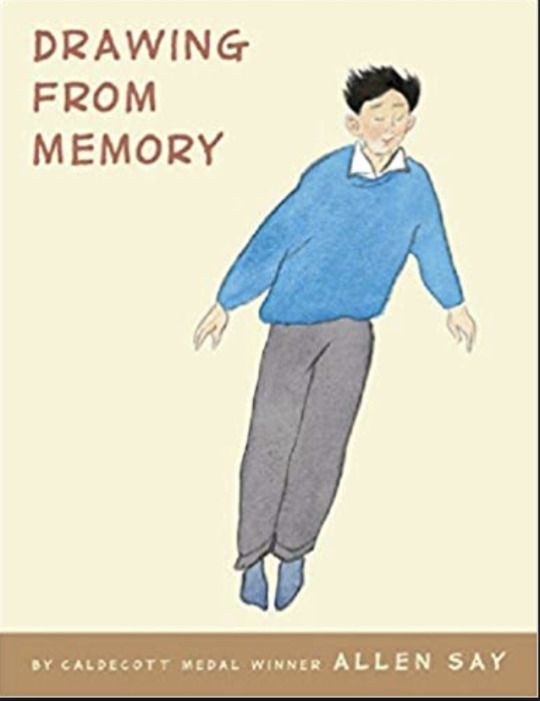
BIBLIOGRAPHY
Say, Allen. 2011. Drawing From Memory. New York: Scholastic Press.
PLOT SUMMARY
In Japan a young boy named Allen loves to draw. On paper and even walls he draws on everything. His father wants him to be responsible and does not like him drawing. Then Allen’s mother takes him and his little sister and move to a village away from war. Allen meets his master who will show him how to draw. Allen is happy that he can draw. As he gets older his father sends him a letter to see if he wants to go to America. “Drawing From Memory” is a journey of how a little boy who draws and stays passionate to his art.
CRITICAL ANALYSIS
“Drawing From Memory” is a biography about the author Allen Say. The reader will see on the cover a young man with his eyes closed and appear to be floating with his black hair blown up in the wind. Allen Say is also the illustrator of his biography. As the reader flips through the pages you will see real photographs of the author and also drawings of that Mr. Say drew by memory. On one page the illustrator drew a group of children sitting on the floor. The children appear to be excited with their mouths drawn open. The illustrator also drew himself sitting at the front of the group reading to the children. In the book it states “I was like a little kamishibai man, a traveling storyteller with picture cards” The reader will connect with the author especially understanding passion of a hobby that they love. “Drawing From Memory” will also have the reader think of their past memories and grab a sketch pad too.
The accuracy of this book is based on the authors memory. Although the reader will see real photos and places about the author. This book is based on the accounts of the authors journey. The organization of this book has breaks and does not have a table of contents to follow by. it does have a few photos of the author’s life and his friends. The design is readable with lovely illustration. The illustration helps the reader understand the text clearly. The style of this book is interesting especially when the author explains about the his favorite cartoonist. The reader will indeed be inspired to document their own story too.
REVIEW EXCERPT(S)
2012 Robert F. Sibert Medal Honor
2012 ALA Notable Children’s Book
From The New York Times Book Review: “...a transporting hybrid of picture book and graphic memoir...[Say] shows just how evocative illustration can be in conveying a life to young readers.”
CONNECTONS
Gather other Allen Say books to read such as:
Grandfather’s Journey 20th Anniversary. ISBN 9780544050501
The Favorite Daughter. ISBN 9780545176620
Stranger in the Mirror. ISBN 9780547347325
Use as an example for students to draw and create a true story about themselves.
0 notes
Text
Genre 3 Poetry
**This is an assignment for my TWU course LS-5603 of book reviews for poetry.
BOOK 1
This is Just to Say: Poems of Apology and Forgiveness by Joyce Sidman Illustrated by Pamela Zagarenski
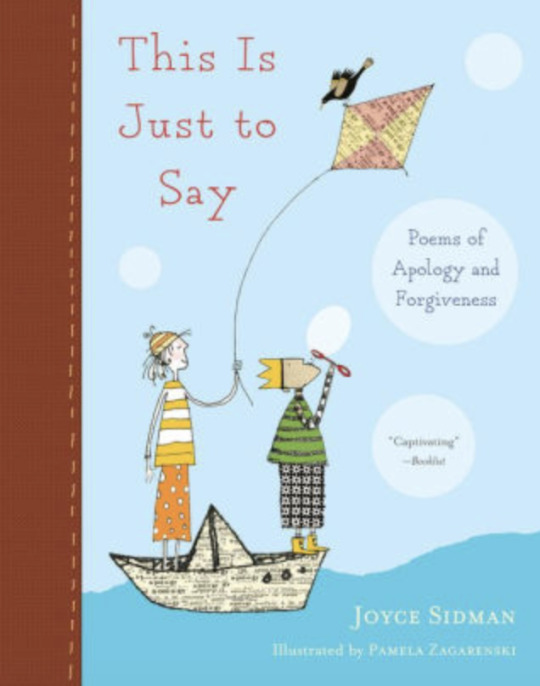
BIBLIOGRAPHY
Sidman, Joyce. 2007. Ill. Pamela Zagarenski. This is Just to Say: Poems of Apology and Forgiveness. New York: HarperCollinsPublishers. ISBN 9780544105072
PLOT SUMMARY
This book contains apologies and responses from a group of sixth-graders and some adults. The beginning of the book has a table of contents, a part 1 and part 2. Part 1 is apologies about donuts, dodgeball and secret messages. Part 2 is the responses to part 1 apologies. The responses are about forgiveness and understanding and will make you laugh, wonder and cry.
CRITICAL ANALYSIS
The reader will be intrigued from the start. In this book of poems of apologies and forgiveness, the author has put together a creative and captivating book. The reader will find out that the majority of these poems are from a group of sixth-graders wrote them as a part of a poetry unit. The reader will eagerly want to read each poem filled with laughter, sadness and guilt. As the reader finishes the apologies section of Part 1. The reader has thoughts of what the responses will be. Will the dad ever forgive the son? Will the teacher forgive the student? The reader will want to read more once they finish the book.
Flipping through the bright colorful pages Zagarenski the illustrator invites the reader to an adventure. Zagarenski creatively integrated dictionary definitions that relates to the poem in parts of the clothing or items on the page. The illustrator for example placed a definition word of “fault” on a skirt of a little girl. The poem with this little girl is called “Lucky Nose” by Bao Vang she states “In a hundred years your nose my be worn down to nothing and so I am very sorry.”( Sidman 2007) The illustrator drew a gray statue of a older lady holding a scroll and the little girl stands in front of the statue on her tiptoes in her fault skirt reaching up to touch the nose of the statue. This gives the reader some kind of understanding why the little girl will have the word “fault” on her skirt. Each page has a connection to what the poem will be about. This gives the reader a guess of what may be read. Overall, this wonderful combination of apologies and forgiveness poems makes you want to grab paper and pen and start you own book of apologies and forgiveness poems yourself.
REVIEW EXCERPT(S)
2008 Claudia Lewis Poetry Award
Cybils Poetry Award
Lee Bennett Hopkins Poetry Award Honor Book
From School Library Journal starred review: “Sidman’s ear is keen, capturing many voices. Her skill as a poet accessible to young people is unmatched...This is an important book both for its creativity and for its wisdom.”
From Kirkus Review: “Packed with the intensity of everyday pain and sorrow, kids and adults exchange the words that convey grief, delight, love and acceptance of themselves and others.”
From Booklist: “Captivating.”
From Book Page: “A standout”
CONNECTIONS
Gather other William Carlos Williams books to read such as:
Poetry for Young People. ISBN 9781402700064
Use “This is Just to Say” book of poems as a introduction into creating a class book of poems about apologies and forgiveness.
BOOK 2
Mirror Mirror: A Book of Reversible Verse by Marilyn Singer Illustrated by Josee Masse
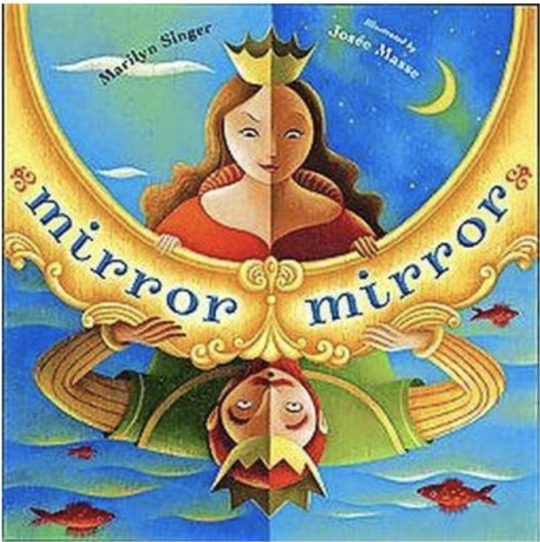
BIBLIOGRAPHY
Singer, Marilyn. Ill. Josee Masse. 2010. Mirror Mirror: A Book of Reversible Verse. New York: Penguin Young Readers Group. ISBN 9780525479017
PLOT SUMMARY
This book starts with a prince and a princess with two views in different perspectives. “Mirror, Mirror” contains familiar fairy tale stories and flips your thinking. From Cinderella’s sparkling shoes to Rapunzel’s cut hair, these reverso poems provide insight into a world of unknown adventures. After reading this book, you will start to wonder how your favorite fairy tale will end in a whole new way.
CRITICAL ANALYSIS
A prince and a princess in a mirror image is what Singer deliberately put together. The reader will be confused at first and then realize that the poems are reversed. Just like a mirror your image is flipped and so are the poems in this book. As the reader moves on reading they may catch themselves already trying to flip the first poem and guess what it will say. Each fairy tale will give the reader a different view of what could have happened in the story. The reader will be excited to think of the new perspective of a classic story.
The illustrator provides the reader with split versions of what happened and what could be. Masse uses bright inviting colors of reds, greens, blues and yellows. Masse also blends each image into each other causing the image to be one cohesive illustrated masterpiece. The image of Sleeping Beauty’s dress changing over into a bed of thorns, gives the reader two views of the story on one page. The reader will be happily excited at the possible stories they can create in their minds by the words and illustration of “Mirror, Mirror”.
REVIEW EXCERPT(S)
2011 Cybil Award for Poetry
2011 ALA Notable
2011 CLA/NCTE Notable
From Horn Book: “Through a verse form she dubs the reverso, Singer mediates on familiar fairy tales and their shadows.”
From Publishers Weekly: “Singer uses “reverso” poems, a form of her creation, to show that there are two sides to every fairy tale (the poems can be read backward and forward).”
From Kirkus Review: “A collection of masterful fairy-tale-inspired reversos -a poetic form invented by the author, in which each poem is presented forward and backward.”
CONNECTIONS
Gather other Marilyn Singer books to read such as:
Follow Follow: A Book of Reverso Poems. ISBN 9780803737693
Echo Echo: Reveso Poems About Greek Myths. ISBN 9780803739925
Use reverso books by Marilyn Singer as an introduction by remaking an old story into a new story activity.
BOOK 3
Inside Out and Back Again by Thanhha Lai
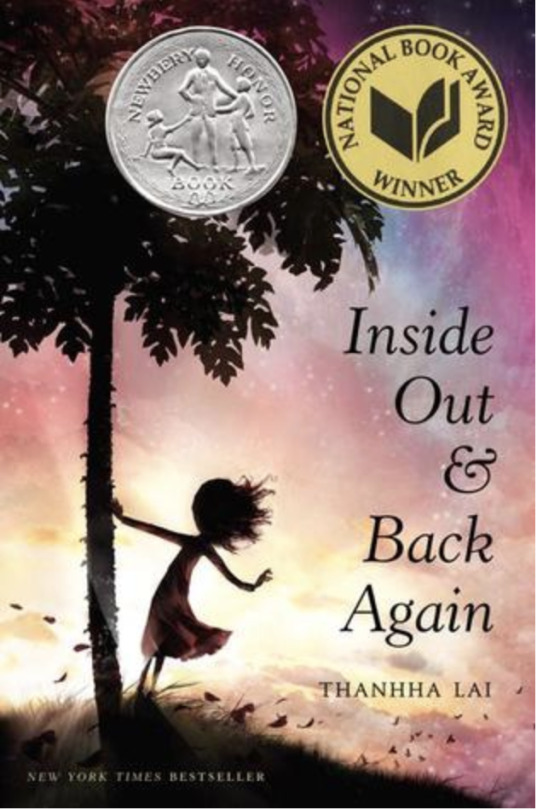
BIBLIOGRAPHY
Lai, Thanhha. 2011. Inside Out & Back Again. New York: HarperCollinsPublishers. ISBN 9780061962790
PLOT SUMMARY
A 10 year old girl who lives in Saigon with her mother and three brothers. The new year has begun, bombs, explosions at a distance occur. This family takes a journey into an unknown land. This poetic free verse book is about the ups and downs of a little girls childhood. Thannha Lai’s “Inside Out & Back Again” takes you on a journey of love, laughter and life.
CRITICAL ANALYSIS
On the cover of this book is a small girl who holds on to a tree while the wind blows. You can not see her face but, the cover make you feel the wind as the leave blow and birds fly. This free verse book starts at part 1 Saigon. The reader will be curious in wondering what this book is about. Each page has white space and words along the inside and outside of the page. The reader will put themselves in the 10 year olds shoes. A the reader they will want to hope for the best for the mother and her family. The reader wants to believe the family will soon see the father. As the reader moves on they will feel the emptiness of their stomachs as they wait to be rescued. One part of the poem it states “the ration is now half a clump of rice” ( Lai 2011) The relief of the loud American horns blowing across the waters. Towards the end of the story the reader has taken a journey with the family and has a better understanding of what it feel like to be in another land that you are not familiar with and try to live and grow.
REVIEW EXCERPT(S)
2012 Newbery Honor Book
2011 National Book Award Winner
From Kirkus Review “An enlightening, poignant and unexpectedly funny novel in verse is rooted in the author’s childhood experiences.”
From Common Sense Media “ Inside Out and Back Again is a memorable story, told beautifully in free verse poetry.”
CONNECTONS
Gather other Linda Sue Park books to read such as:
A Long Walk to Water. ISBN 9780547577319
Gather other Lois Lowry books to read such as:
Number the Stars. ISBN 9780547577098
Gather other Pam Munoz Ryan books to read such as:
Esperanza Rising. ISBN 9780439120425
Use “Inside Out & Back Again” as an introduction into reading free verse poetry books.
0 notes
Text
Genre 2 Traditional Literature Book review by P. Johnson
**This is an assignment for my TWU course LS-5603 of book reviews for traditional literature.
BOOK 1
The Three Little Tamales by Eric A. Kimmel Illustrated by Valeria Decampo
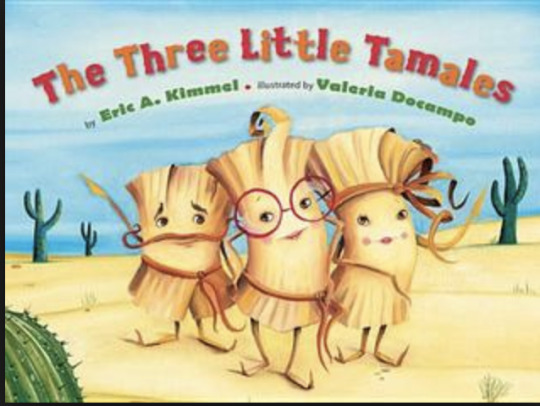
BIBLIOGRAPHY
Kimmel, Eric A. 2009. The Three Little Tamales. Ill. by Valeria Docampo. New York: Marshall Cavendish Corporation. ISBN 9780761455196
PLOT SUMMARY
Three little tamales set out to leave their taqueria due to the dilemma that tortilla has addressed to them. First, tamale finds a cozy sage smelling place to live. The second, tamale finds a casita in the cornfields. The third, tamale build a cactus home that will be help protect it. All three tamales live happy until another dilemma occurs. Senor Lobo is looking for yummy tamales to eat. The first and second tamale narrowly get away and make it to the third tamales cactus protected home. Senor Lobo has a hard time getting to the three tamales. The three tamales teach Senor Lobo a lesson and the three little tamales have a fiesta.
CRITICAL ANALYSIS
Kimmel sets this unique story in Texas. With it’s Mexican style and soft colored illustration. Docampo’s illustration invites you into light browns and festive colors as you turn the pages. The reader will enjoy seeing three characters with features of a headband, red glasses and a mustache. The story provides senses of smell, sound and touch. Smell is the scent of the taqueria and also the scent of the sagebrush. The sounds of the cornstalks in the night wind and the texture of cactus pricking paws. The reader will want to know what will happen next as the tamales flee their home to the third tamales house. As the reader senses the good will win over evil a sigh of relief passes over. At the end of the story a celebration brings the story to close.
REVIEW EXCERPT(S)
From School Library Journal “ Kimmel has pulled the pork from “The Three Little Pigs” wrapped it in masa, and cooked up another traditional tale flavored with Southwestern spice.”
CONNECTIONS
Gather other Eric Kimmel books to read such as:
Cactus soup. ISBN 9780761455196
Three Cabritos. ISBN 9780761463092
Use this story as an introduction to learning Mexican words.
BOOK 2
The Three Horrid Little Pigs by Liz Pichon

BIBLIOGRAPHY
Pichon, Liz. 2008. The Three Horrid Little Pigs. Wilton: Tiger Tales. ISBN 9781589250772
PLOT SUMMARY
Once upon a time a mother pig kicks out her three horrid pigs. Due to their constant destructive behavior. The pigs ventured out to find their new homes. The first pig takes straw from the cows to build his home. When a big friendly wolf sees this house and as a builder, Wolf know this first pig needs some help. Unfortunately, pig rudely tells wolf no. As wolf moves on he runs across a home terribly made of sticks. When he asks the second pig if he needed help, again this pig shouts for wolf to keep moving. On his way home wolf finds the third wolf not even in his house. The pig has taken over a chicken coop. Wolf approaches the third pig and again he is told to leave. Wolf kindly takes in the chickens. Lots of issues happen and the pigs have no place to call home. Overall, this story mixes up the three little pigs” into a unique and caring story at the end.
CRITICAL ANALYSIS
The cover of the book explains a lot about these three little horrid pigs. Eyes are tiny and the face look like these pigs are bad. One pig has his tongue sticking out. Another with his arms cross holding tight a bushel of straw. The last one has a chocolate donut and really needs to clean his face. The reader will be intrigued when seeing this cover. Far behind the pigs on the cover is a wolf who looks well dressed with a red box in his hand. Curiosity will captivate the reader by the title with questions like “What is horrid? and Is it the three little pigs or the wolf.” These bright colorful illustrated pages takes the reader into a world of talking pink pigs and a tool welding wolf. Movement in the book is illustrated with wispy lines to show stick and straw falling. At the end of the story the reader will be on the edge of their seat wondering what happen to those three pigs and a wolf who has a big pot of boiling at the bottom of his chimney. With hilarious laughter and some nail bitting suspense “The Three Horrid Little Pigs” will want you to read it over and over again.
REVIEW EXCERPT(S)
From Booklist “This fracture take on “The Three Little Pigs” is infused with humor and lesson about community and compassion.”
CONNECTIONS
Gather other Jon Sciezka books to read such as:
The True Story of the Three Little Pigs. ISBN 9780140544510
Gather other Eugene Trivizas books to read such as:
The Three Little Wolves and the Big Bad Pig. ISBN 9780689815287
BOOK 3
The Lion and the Mouse by Jerry Pinkney
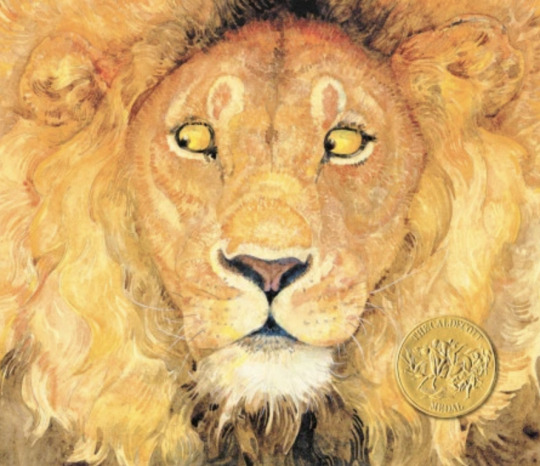
BIBLIOGRAPHY
Pinkney, Jerry. 2009. The Lion and the Mouse. New York: Little Brown and Company. ISBN 9780316013567
PLOT SUMMARY
This is the story of a lion and a mouse. A meeting that could have ended badly but, the lion kindly releases the mouse. Saving the mouse life. The lion moves on roaming the lands of Africa. The mouse moves on searching maybe for food. Two men lay out a net to capture animals. The lions luck surprisingly changes and he gets caught in the net. Ending with a grateful lion saved by an unexpected hero. This story of “The Lion and the Mouse” takes you on an African journey of surprising encounters and odd couple acquaintance.
CRITICAL ANALYSIS
This picture book begins before opening the book. A huge lion is painted on the cover. With eyes looking to the side. Pinkney has out done himself as the author and illustrator. One the title page the illustration shows huge paw prints in the mud and a small mouse sitting in one of those large prints. As the reader turns the page they have stepped into an African night.
Pinkney uses few words to create sounds of the night like a owl who, who among the moonlight sky. The read will then see a large lion and a mouse in its paw the reader wonders if this is the end for the mouse. The suspense is overwhelming as Pinkney illustrates a lion with its large mouth and teeth open as it holds the little mouse. The reader will wonder will the lion eat the mouse. To the readers surprise the little mouse is release by the big lion. The motions of two men hammering a net catches the readers attention. Illustrated on the next page is a close up of a two large paws about to cross over a part of the net. The reader will watch as such a huge lion is rescued by a small mouse and an unbelievable association is created. “The Lion and the Mouse” is like the odd couple you never thought could happen. Jerry Pinkney’s illustration is a masterpiece in its own right.
REVIEW EXCERPT(S)
2010 CALDECOTT AWARD
From Publisher’s Weekly: “Other than some squeaks hoots, and one enormous roar, Pinkney’s ( Little Red Riding Hood) interpretation of Aesop’s fable is wordless-as is its striking cover, which features only a head on portrait of the lion’s face.”
From School Library Journal “ This wordless iconographic rendering of Jerry Pinkney’s Caldecott winner (Little, Brown, 2009), is filled with action, suspense, and song.”
CONNECTONS
Gather other Caldecott Medal books to read such as:
Wiesner, David. Flotsam. ISBN 9780618194575
Have students draw a picture book and share with class in their own words what the story is about.
0 notes
Text
P. Johnson book review of Caldecott, Picture, & Classic books
This Is Not My Hat by Jon Klassen
Caldecott Award medal/honor book

Bibliography
Klassen, Jon. 2012. This Is Not My Hat. Somerville: Candlewick Press. ISBN 9780763655990
Plot Summary
In “This Is Not My Hat” by Jon Klassen the main character is a little fish admitting to a confession. The journey of a little fish, a big fish, and a truthful acquaintance set in a body of water. Little fish starts out swimming with excitement in dark waters chatting about big fish not realizing little fish took his hat. Little fish still oblivious to the fact that big fish has indeed realized someone took his hat swims on without fear and confidence. Even when little fish has been seen by another he insist that the small hard shell red sea animal would not tell on him. Unfortunately, for the little fish, this crab appears to understand the difference of right and wrong. Little fish thinks his plan to hide where no one will find him appears to not work and in a shocking end Jon Klassen has invited the opening to a mystery only the reader can try to figure out.
Critical Analysis
The curiosity of wanting to know what will happen next keeps the attention of the reader. Klassen strategically pulls the reader into a journey of adventure. What will happen next? How will this end? are just a few questions. Klassen put together an adventure of guessing and humor. Big fish who is sleeping, immediately realizes someone took his hat by his illustrated eyes popping open and then looking up towards the top of his head and no hat in sight. As the reader flips the pages, they will see the little acquaintance express itself with a hard shell red body and big popping eyes and see he is pointing towards the direction the little fish went. The humor and curiosity of the story comes alive. Going into a hidden underwater forest and finding out what comes next keeps you guessing and wondering for more. Readers of all ages will enjoy the works of Klassen’s latest book “This is Not My Hat”.
Review Excerpt(s)
2013 CALDECOTT MEDAL
From Kirkus Reviews: “ Klassen provide spare text and art to deliver no small measure of laugh of another darkly comic haberdashery whodunit... Hats off!”
From Bulletin of the Center of Children’s Books: “This is, quite simply, and outstanding book- and that ain’t no fish tale.”
From Publishers Weekly: “Klassen excels at using pictures to tell the parts of the story his unreliable narrators omit or evade.”
Connections
Gather other Caldecott Medal books read such as:
Klassen, Jon. This is Not My Hat. ISBN 9780763655983
Gather other Michael Rex books to read such as:
Rex, Michael. Eat Pete. ISBN 9781524738808
Gather other Julia Sarcone-Roach books to read such as:
Sarcone-Roach, Julia. The Bear Ate Your Sandwich. ISBN 9780375858604
Use as an introduction for retelling stories about beginning, middle and end.
Use as an example for writing stories and predicting your own ending to similar books like above.
A Big Guy Took My Ball! by Mo Willems
Picture book
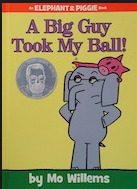
Bibliography
Willems, Mo. 2013. A Big Guy Took My Ball! New York: Hyperion Books for Children. ISBN 9781423174912
Plot Summary
Mo Willems the author of “A Big Guy Took My Ball!” sets Piggie with a dilemma. Piggie goes to her friend to rant about a big guy taking her ball. Piggies friend Gerald takes off to get back his friends ball. Once Gerald realizes how big the big guy really is Gerald has a dilemma too. Although, Gerald is a bigger than Piggie, Gerald is NOT the big guy. To both Piggie and Geralds surprise this mystery big guy is in need of some help too. “A Big Guy Took My Ball” is a friendship book with fun loving socialization.
Critical Analysis
The readers will dive into this well written fun loving book. A small pig, A medium elephant and a large friend provides the reader a mathematical problem looking to be solved. On crisip white pages the illustration of Piggie, Gerald and the big guy pop from the pages. The reader will be eager to read more page by page. With color coded speech bubbles the reader will know which character is talking. Wanting to know if Piggie ever got her ball back. Who was this “Big Guy”? With a sweet ending Mo Willems has captured real friendships and new ones too.
Review Excerpt(s)
2014 THEODOR SEUSS GEISEL HONOR
From Common Sense Media by Darienne Stewart: “A Big Guy Took My Ball!” “is a smart and funny take on playground conflict with a sweet lesson even grown-ups sometimes struggle to remember”
Use book to introduce sizes small, medium, large, and weight heavy and light.
Use for building social skills by having students work on communication skills.
Connections
Gather other Jeremy Tankard books to read such as:
Tankard, Jeremy. Grumpy Bird. ISBN 9780439851473
Gather other Melanie Watt books to read such as:
Watt, Melanie. Scaredy Squirrel. ISBN 9781554530236
Sylvester and the Magic Pebble by William Steig
Classic book
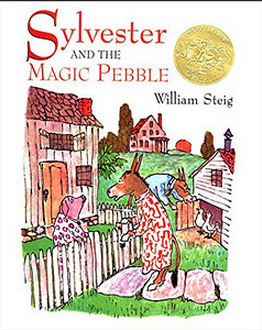
Bibliography
Steig, William. 1969. Sylvester and the Magic Pebble. New York: Simon & Schuster. IBSN 9781416996156
Plot Summary
William Steig is the author of “Sylvester and the Magic Pebble” the story is set in a community of animals. Sylvester who is a donkey collects pebbles and finds a magic pebble. Once Sylvester realizes this pebble is magical he is excited with all the possibilities. On his way home Sylvester is confronted with danger. Sylvester uses the magic pebble for help. Sylvester is separated from his parents. After some obstacles and waiting Sylvester has reunited with his parents and the magic pebble is put up for safe keeping.
Critical Analysis
In “Sylvester and the Magic Pebble” by William Steig, the reader will notice the illustration to be bright and vibrant. As the reader flips the pages they will see alluring patterns that catch your eye. Each page have drawings with peep hole views of detail. The reader will hope for Sylvester to return home. As the story comes to an end, the reader will feel a sense of love and happiness but, overall family.
Review Excerpt(s)
1970 CALDECOTT MEDAL
From American Library Association Caldecott winner blurb “Sylvester and the Magic Pebble is a charming, tender story about the experiences of a donkey named Sylvester and his family after he finds and makes a wish upon a magic pebble.”
From Eric Carle “ I am delighted that this magical book by William Steig - a magical himself- has been reissued. May it stay in print forever.”
Connections
Gather other Caldecott Medal books to read such as:
Brown, Marcia. Cinderella, or the Little Glass Slipper. ISBN 9780684126760
Thurber, James and Slobodkin, Louis. Many Moons. ISBN 9780156569804
Use as an introduction to adding detail to drawing pictures.
Use with telling stories and becoming your own author and illustrator.
Book reviews by Pasha Johnson
0 notes
Text
Ready, Set, Read!!!
Hello my name is Pasha. I am currently taking a course with TWU called LS 5603/20-21 “Literature for Children and Young Adults”. This blog will be used to provide my insight and review of books selected for this course. Let’s get started...Ready, Set, READ!!!
1 note
·
View note
